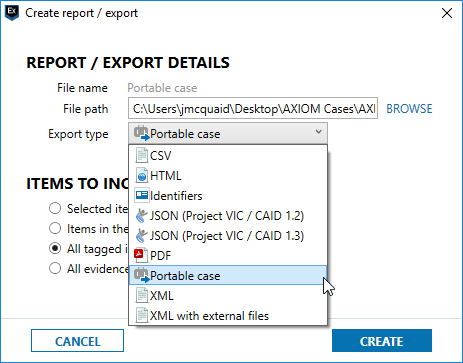Portable Case Makes Collaborating on Case Easier
One of the hidden gems of Magnet AXIOM and Magnet IEF is the ability to create a Portable Case. A Portable Case can be created by any AXIOM or IEF user to collaborate on a case with other stakeholders and it can include all the digital evidence that has been acquired and recovered in a case — or the examiner can omit pieces that shouldn’t be shared.
Our customers tell us there are two use cases that really showcase the ways that Portable Case helps them: by making their cases easy to share, and making it easy to collaborate on cases with other team members.
In this post, we will talk a bit more about how team members can leverage Portable Case to collaborate on cases, play to each other’s strengths, and reduce turnaround time.

Portable Case for Collaboration
AXIOM and IEF are both able to grab phone dumps and image hard drives, but can also ingest images from other third-party solutions like Cellebrite, EnCase, FTK and more. AXIOM uniquely recovers data from cloud services and adds that into the digital evidence from smartphones, computers, drives, and third-party images.
This is important to note because a Portable Case sent from AXIOM can be very robust in terms of the amount and type of data shared. It helps paint the whole picture of the evidence. A Portable Case can be used to analyze all retrieved content in the form of artifacts without needing the original source evidence.
If you haven’t used AXIOM, one of the things that makes it extremely easy to use is that it takes all data collected from all sources and compiles that data back into artifact form – if you are looking for Skype chats, you will see the familiar Skype logo and the information can be presented visually to look like a Skype chat.
How does all of this speak to collaboration? With the mass volumes of smartphones, laptops, being delivered to digital forensics teams, labs, or solo examiners, having a tool that allows you to share out all the case evidence while maintaining a single primary case file allows people to share the workload more easily.
If you have team members who have expertise in chat analysis, or email analysis, or photo analysis, you can easily share out the evidence and have them analyze those files, and then merge their findings back into the main case. This is a great way to delegate the time-intensive analysis and move through the case more quickly, while still maintaining case and evidence integrity.
Learn More about Portable Case
Next week, we will discuss the ways Portable Case is used for case review by stakeholders. We will also be posting a new Portable Case case study in our Customers section, hosting a new webinar with Tayfun Uzun: Sharing is Caring: Empowering the Whole Team to Collaborate (register here), and introducing a getting started on Portable Case tutorial from our training group.
For more detailed information on Portable Case, our forensics experts did a two-part deep dive here:
If you have an AXIOM license, be sure to give our Portable Case feature a try. If you don’t have AXIOM, request a free 30-day trial.